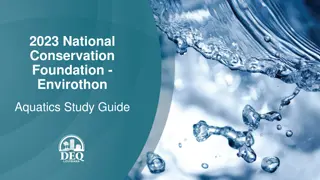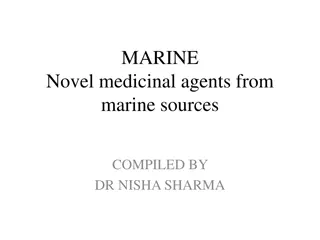Aquatic Adaptations in Marine Life
This informative content discusses the primary and secondary aquatic adaptations in marine animals such as fish, whales, turtles, and ducks. It covers various adaptations like streamlined bodies, presence of swim bladders, flippers for navigation, and webbed feet for swimming. Each adaptation is vital for survival and efficient movement in the aquatic environment.
Download Presentation

Please find below an Image/Link to download the presentation.
The content on the website is provided AS IS for your information and personal use only. It may not be sold, licensed, or shared on other websites without obtaining consent from the author.If you encounter any issues during the download, it is possible that the publisher has removed the file from their server.
You are allowed to download the files provided on this website for personal or commercial use, subject to the condition that they are used lawfully. All files are the property of their respective owners.
The content on the website is provided AS IS for your information and personal use only. It may not be sold, licensed, or shared on other websites without obtaining consent from the author.
E N D
Presentation Transcript
AQUATIC ADAPTATIONS DR.DALIP KUMAR
AQUATIC ADATATIONS Primary Aquatic Adaptations Secondary Aquatic Adaptations
Primary Aquatic Adaptations Streamlined Body Lateral line for equilibrium Nicitating membrane is presrent in eyes for clear vision in water Presence of swim bladder in bony fishes serve as accessory respiratory organ as well as hydrostatic organ Anal fin helps to stabalize the fish while swimming Absence of pinna Presence of scales
Secondary Aquatic Adaptations WHALE : Flippers help to navigate and steer Flukes used for propulsion Small eyes and secrete oil used to protect eyes from debris Presence of blowhole which act as a airway passage for breathing Dorsal fin maintains equilibrium Presence of baleen
Secondary Aquatic Adaptations TURTLE : Presence flippers instead of feet Front flippers help to generate thrust and back flippers used for steering Respiration by special organ, in cloaca finger like projections are present called papillae which increases the surface area so that turtle can take up oxygenated water through it
Secondary Aquatic Adaptations DUCK (WEBBED FEET ) Webbed feet helps to swim faster and act as paddle Waterproof feathers Light weight skeleton Stiff flexible feathers on the tip of their wings so they can easily push the air back creating thrust Strong beak to gather and hold food Presence of preen glands used for oiling
Secondary Aquatic Adaptations DUCK BILLED PLATYPUS Tail is made up of fatty tissue that is used to store energy Tail helps in insulation also Tail is used for steering while swimming Streamlined and dorso-ventrally compressed body Rubbery snout Nostrils are located on the dorsal surface of the snout

























